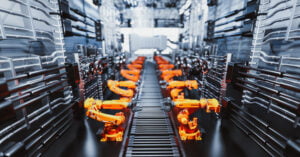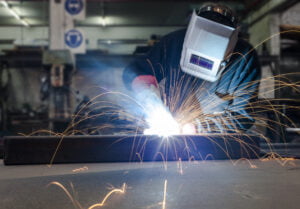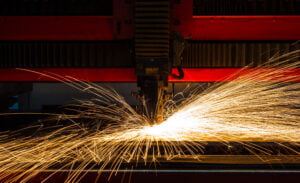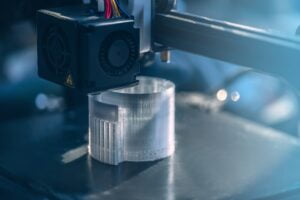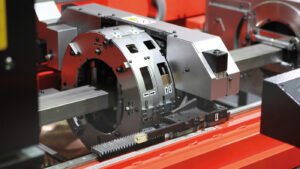Introduction
Welding is a fabrication process used to join materials through fusion, using heat. Usually, welding is used on metals and plastic. In welding, the base material is usually melted. A filler material is commonly used. It is added to the molten material, known as the weld pool, which can cool to form a joint that can be stronger than the base material.
History
Welding can be traced back as far as the Bronze age. The iron pillar of Delhi, India is an example of early welding, as far back as 310AD.
During the Middle Ages, blacksmiths would perform a technique known as forge welding. Metal is heated until red hot and hammered together. Deformation occurs in the weld faces, forming a metallic bond between the two surfaces.
The short pulse electrical arc was discovered by Sir Humphry Davy in 1800. Two years later, in 1802, a Russian scientist named Vasily Petrov discovered the continuous electrical arc. This led to Polish and Russian inventors developing the first arc-based welding technique known as carbon arc welding. In this method, a carbon electrode forms an arc between itself and the workpiece. This heats the workpiece, allowing it to bond with other metals.
Leading into and through the 20th century, welding became more important due to the two World Wars. This caused a surge in development, with many improvements being made to techniques. World War One saw shielding gasses being tested to protect welds from oxidation and atmospheric pollutants. World War Two caused the invention of stud welding, submerged arc welding, gas tungsten arc welding, gas metal arc welding, shielded metal arc welding, flux-cored arc welding, plasma arc welding and electrogas welding.
Welding Processes
Arc welding methods are among the most commonly used. These require a power supply, some make use of DC and others AC, to supply electrical current. Electrodes are used to allow the current to arc, jump through the air. The electrode used can be either consumable or non-consumable. Commonly, a gas is used to shield the weld area from oxidation. Also, a filler material is regularly used. In general terms, arc welding works by forming a high-current arc between an electrode and the workpiece, resulting in the workpiece being heated. Once the workpiece is hot enough, it will melt and form a pool of molten metal, the weld pool. As this molten metal cools, it will fuse with material on the part it is to join with and will form a very strong joint when cool. Regularly, a shielding gas is used. This is an inert, non-reactive, gas that is fired over the weld area. It keeps oxygen away from the molten metal, preventing oxidation. If the weld oxidises, the weld strength is compromised as the metal oxide will be brittle and porous. The gas also keeps any pollutants out of the weld, these will create impurities and also compromise the weld strength.
Gas welding is one of the most versatile welding techniques. While not commonly used in industry due to better techniques being accessible, it is still widely used for pipes, tubes and repair work. The equipment required is relatively cheap and simple, making this an accessible method for hobbyists. Gas welding makes use of flammable gasses to produce a high-temperature flame. This flame is used to melt the metal workpieces and cause fusion. As the flame isn’t very concentrated, the weld cools slowly and can increase stresses in the metals.
Resistance welding exploits the high resistance of metals when they are in contact. Electrodes are used to clamp two pieces of metal together and pass a current through the metal. The current can be as high as 100,000A. Where the two pieces of metal are in contact, there is a high amount of electrical resistance, which causes heat. This heat causes the two metals to melt where they are in contact, causing the joint to fuse.
Two kinds of energy beam welding exist, namely laser beam welding and electron beam welding. The two methods differ primarily in their source of fuel. In general, a beam of energy is used to melt the metals at the joint, fusing the two pieces. Laser beam welding utilises a laser beam to heat the metals, while electron beam welding uses a beam of high energy electrons. Electron beam welding is performed in a vacuum to prevent the electrons from colliding with air particles, which would be a waste of energy. Energy beam welding is generally very fast and can be automated easily, however, the equipment required is expensive and the formed welds are prone to thermal cracking.
Solid-state welding techniques don’t melt the workpieces. The forge welding method mentioned is an example of solid-state welding, the workpieces are heated until they glow, but they are never melted. A variety of solid-state welding techniques exist, usually using pressure rather than heat.
MIG, TIG and Spot
For general fabrication work, three welding methods are universally used. Additional methods are also used, but they are more application dependant. The vast majority of fabrications make use of MIG, TIG and spot welding.
MIG welding, or metal inert gas, is a form of arc welding. An electrode wire will form an arc to the workpieces, using an attached power supply. This arc heats the metals and causes them to melt. As they melt, the molten metal will pool together and fuse during cooling. An inert shielding gas is used, usually a mixture of Carbon Dioxide and Argon. MIG welding is relatively easy to learn and can produce a good finish.
TIG welding, or tungsten inert gas, is another arc welding method. A tungsten electrode is used to form an arc, powered by a constant current supply. Again, this arc is used to melt the workpieces. Between the electrode and workpieces, a column of ionized gasses and the metal vapour will form, this is a plasma. Plasmas are highly conductive, so this plasma column will assist in conducting the arc. A shielding gas is used for TIG welding, commonly Argon or Helium, to prevent oxidation. A filler material is also used for most forms of TIG welding to ensure there is enough material in the weld pool to properly fuse. TIG welding affords more control over the weld to the operator, making it useful for awkward welds, but this additional control means higher complexity, making TIG more difficult to learn than MIG.
Spot welding is a form of resistance welding. Two copper alloy electrodes are used to deliver a high current to thin metal sheets. The electrodes clamp the sheets together and the high current causes a large amount of heat to build where the sheets are in contact, as this is where the most resistance is. This causes the metal to melt, which will fuse as it cools. When spot welding, the current strength and duration are chosen based on the material properties of the workpieces. Too little current and duration won’t generate the heat required, resulting in a poor weld or none at all. Too much current will cause the metal to melt, but will also shoot the molten metal out, forming a hole rather than a weld. Spot welding is easily automated, with spot welders being regularly mounted on robotic arms on production lines, especially common in automotive manufacture.


